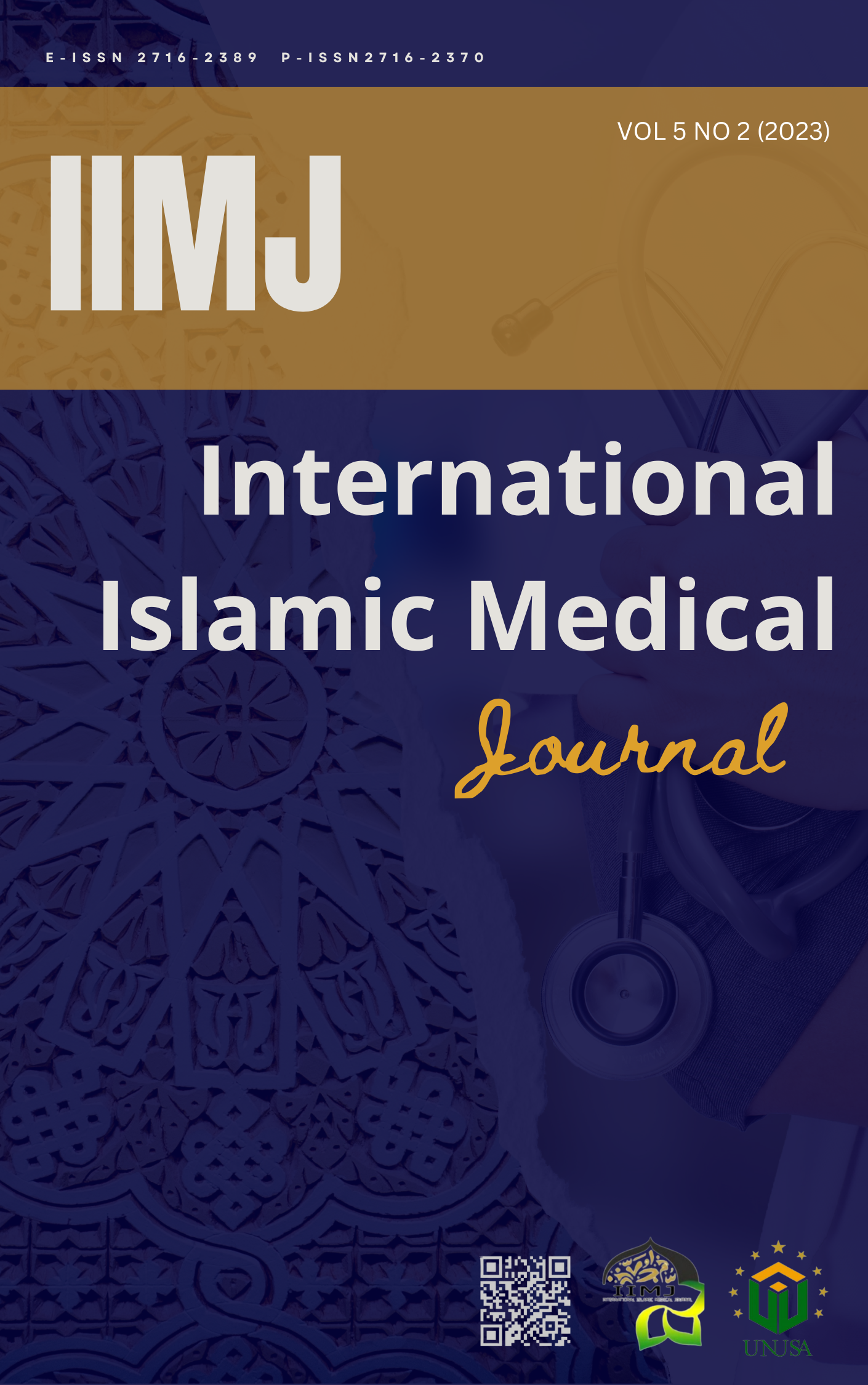Effect of Musical Therapy on Malondialdehyde Levels on Male Mice Brain Tissue
Main Article Content
Abstract
Introduction: An example of a non-pharmacological therapy that is currently being developed is music therapy. The serenity created from classical music and murottal therapy is good for therapy performance, accelerating the healing process, and also reducing stress level.
Objective: The aim of this study was to examine the effects of classical music "Mozart" and Murottal Al-Qur’an therapy on mouse malondialdehyde levels
Methods: This study used 24 male BALB/c strain mice (10-12 weeks), in a true experimental setting using the Post Test Only Control Group Design. Four groups of mice were created: K (control), P1 (murottal Al-Qur'an), P2 (classical music "Mozart"), and P3 (combination therapy). SPSS 24 was used to analyze the data with a significance P < 0.05
Results: According to study findings, the P2 group had the highest average malondialdehyde level meanwhile the lowest average malondialdehyde levels was found in Group P1. The test results showed no significant relationship (p = 0.213)
Conclusions: The findings of this study showed that there was no significant correlation between malondialdehyde levels when "Mozart" classical music and Murrotal treatment were given. The group who received the classical music "Mozart" nevertheless, had higher malondialdehyde levels, according to the findings.
Downloads
Article Details
Copyright (c) 2024 Irmawan Farindra, Akbar Reza Muhammad, Hafid Algristian, Warda Elmaida Rusdi, Dyah Yuniati

This work is licensed under a Creative Commons Attribution-ShareAlike 4.0 International License.
References
Amanah, L., & Esterlita Purnamasari, S. (2015). Efektivitas Mendengarkan Bacaan Al-Qur’an Terhadap Penurunan Tingkat Depresi pada Lansia. Insight: Jurnal Ilmiah Psikologi, 17(1), 11–28. https://doi.org/10.26486/PSIKOLOGI.V17I1.681
Berridge, K. C., & Robinson, T. E. (1998). What is the role of dopamine in reward: Hedonic impact, reward learning, or incentive salience? Brain Research Reviews, 28(3), 309–369. https://doi.org/10.1016/S0165-0173(98)00019-8
Burrai, F., Sanna, G. D., Moccia, E., Morlando, F., Cosentino, E. R., Bui, V., Micheluzzi, V., Borghi, C., & Parodi, G. (2020). Beneficial Effects of Listening to Classical Music in Patients With Heart Failure: A Randomized Controlled Trial. Journal of Cardiac Failure, 26(7), 541–549. https://doi.org/10.1016/J.CARDFAIL.2019.12.005
Dobyns, E. L., Carpenter, T. C., Durmowicz, A. G., & Stenmark, K. R. (2006). Acute Respiratory Failure. Kendig’s Disorders of the Respiratory Tract in Children, 224–242. https://doi.org/10.1016/B978-0-7216-3695-5.50017-1
Fang, Y. Z., Yang, S., & Wu, G. (2002). Free radicals, antioxidants, and nutrition. Nutrition, 18(10), 872–879. https://doi.org/10.1016/S0899-9007(02)00916-4
Gooding, L. F. (2018). Music Therapy in Mental Health Treatment. Music Therapy: Research and Evidence-Based Practice, 47–61. https://doi.org/10.1016/B978-0-323-48560-9.00004-8
Gropper, M. A., & Miller, R. D. (2020). Miller’s anesthesia (9th Edition). Elsevier.
Guétin, S., Soua, B., Voiriot, G., Picot, M. C., & Hérisson, C. (2009). The effect of music therapy on mood and anxiety–depression: An observational study in institutionalised patients with traumatic brain injury. Annals of Physical and Rehabilitation Medicine, 52(1), 30–40. https://doi.org/10.1016/J.ANNRMP.2008.08.009
Irmachatshalihah, R., Armiyati, Y., Studi, P., Keperawatan, I., Kesehatan, D., & Semarang, U. M. (2019). Murottal Therapy Lowers Blood Pressure in Hypertensive Patients. Media Keperawatan Indonesia, 2(3), 97–104. https://doi.org/10.26714/MKI.2.3.2019.97-104
Kurniasari, S., Hepi Yanti, A., & Rima Setyawati, T. (2017). Kadar Malondialdehyde Induk dan Struktur Morfologis Fetus Mencit (Mus musculus) yang Diperdengarkan Murottal dan Musik Rock pada Periode Gestasi. Protobiont, 6(3), 89–97.
Mfotie Njoya, E. (2021). Medicinal plants, antioxidant potential, and cancer. Cancer: Oxidative Stress and Dietary Antioxidants, 349–357. https://doi.org/10.1016/B978-0-12-819547-5.00031-6
Olshansky, B., Sabbah, H. N., Hauptman, P. J., & Colucci, W. S. (2008). Parasympathetic nervous system and heart failure: pathophysiology and potential implications for therapy. Circulation, 118(8), 863–871. https://doi.org/10.1161/CIRCULATIONAHA.107.760405
Rebecchini, L. (2021). Music, mental health, and immunity. Brain, Behavior, & Immunity - Health, 18. https://doi.org/10.1016/J.BBIH.2021.100374
Saraswati, D. A. G. P. (2014). Pengaruh Terapi Musik Relaksasi Instrumental Terhadap Tingkat Kecemasan Pasien Stroke di Ruang HCU BRSU Tabanan. Universitas Udayana.
Yinger, O. S. (2018). Music Therapy in Gerontology. Music Therapy: Research and Evidence-Based Practice, 95–110. https://doi.org/10.1016/B978-0-323-48560-9.00007-3
Yunus, E. S., Arismunandar, P. A., & Rukanta, D. (2021). Scoping Review: Pengaruh Mendengarkan Murottal Al-Quran terhadap Tingkat Stres Orang Dewasa. Jurnal Integrasi Kesehatan & Sains, 3(1), 110–116. https://doi.org/10.29313/JIKS.V3I1.7503
Zahra, A., Nugroho, W., & Kusrohmaniah, S. (2019). Pengaruh Murattal Alquran Terhadap Tingkat Stres Mahasiswa Muslim di Yogyakarta. Gadjah Mada Journal of Professional Psychology (GamaJPP), 5(2), 108–119. https://doi.org/10.22146/GAMAJPP.50354

